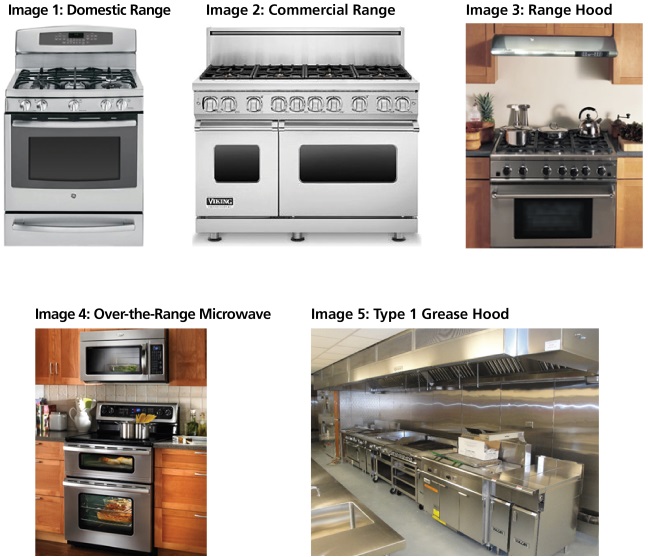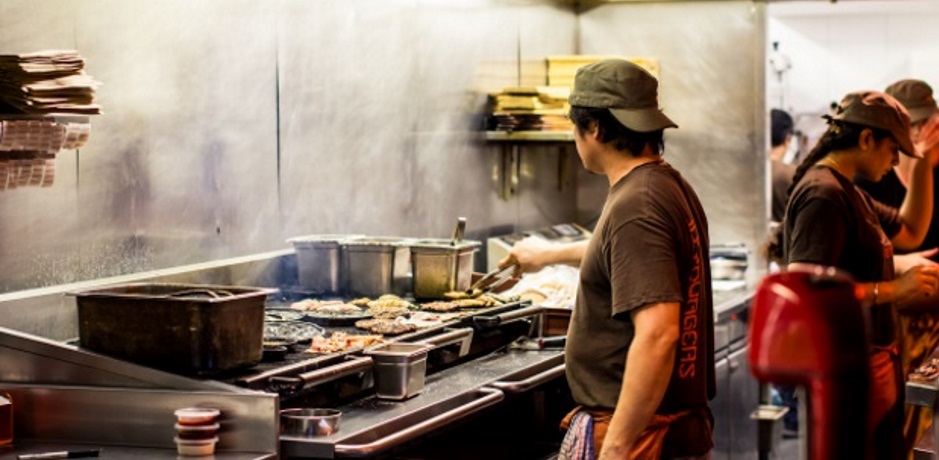What’s Cooking? Domestic Ranges in Commercial Buildings
The National Fire Protection Association (NFPA) standard 96 clearly states the requirements for Type I grease hoods over commercial cooking equipment, but what are the requirements for hoods over domestic cooking equipment and how should we approach the installation of domestic cooking equipment in a commercial facility?
We should always consider what makes the most sense from the user’s point of view and be mindful of the code requirements
Let’s start with examples of possible installations.
- Image 1 shows a domestic range with 5 burners totaling about 38,200 btu/hr.
- Image 2 show a commercial range with 8 burners totaling about 145,000 btu/hr.
- Image 3 shows a range hood over a domestic range.
- Image 4 shows an Over-The-Range microwave. These microwaves are also called Microwave Hood Combinations because they have a built-in exhaust fan for doing what the range hood does.
- Image 5 shows a Type 1 grease hood over a commercial cooking lineup.

Selecting a Range
It is a common agreement that if a building has commercial cooking equipment that produces grease vapors or smoke, then it needs a Type 1 hood. But the type of hood installation over domestic cooking equipment depends on how the equipment is used, the type of building in which it’s installed, and the state in which the building is located.
Many states such as Arkansas, Florida, Maryland and North Carolina do not differ from the International Mechanical Code’s exception that allows ductless range hoods over domestic cooking equipment. This means that the hood shown in Image 3 or 4 will pull that hot, smoky, smelly, greasy air through charcoal filters then blow it in the user’s face. In reality, the charcoal filters only work for a few minutes before they become useless!
In the State of Virginia, gas-fired domestic cooking appliances in other than Group R occupancies (such as dormitories or apartment buildings) must have a Type 1 hood. This is a big deal and can be expensive for the owner. Think of an office building that has a gas-fired domestic range in a break room. That range would require a Type 1 hood, an automatic fire suppression system, and a separate grease exhaust system!
In the State of Georgia, commercial installations of domestic cooking equipment must have a ducted range hood that is vented to the outside. The ductwork can be regular galvanized steel, not like the welded grease ductwork for a Type 1 hood. The range must also be protected by a self-contained residential fire suppression system.
So, depending on the project specifics, a domestic range would either need a ductless range hood that recirculates air in the kitchen or a range hood that is ducted to the exterior, or a Type 1 grease hood.
Going Beyond the Code
An example of when to install a system that goes above and beyond the code might be an apartment building where some codes allow the use of a ductless range hood. A question I often hear from facilities personnel is “what happens when the kids burn the popcorn on the stove?” Well, if they have a ductless range hood, then the hood will blow the smoke in their face and might set off the smoke detectors. Ducting the range hood to the exterior is usually easy, low cost and extremely useful in getting rid of that hot, smoky, smelly, greasy air. We should always consider what makes the most sense from the user’s point of view and be mindful of the code requirements.
Comments ( 1 )
The comments are now closed.


Colin,
Your post is interesting and we are seeing many of the large range manufactures that have “residential” cook tops that are as as close to commercial as you can get. We did not see a mention of a scenerio where a UL300a suppression system like the Kitchensafe sytem can be used in a commercial application. Tom Coffin, Kitchensafe Sales and Training http://www.kitchensafe.net